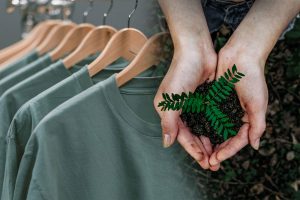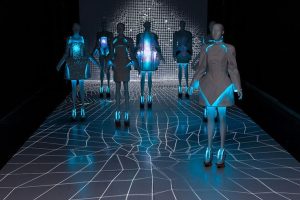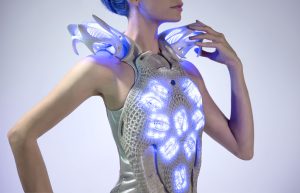Introduction
Fashion has always mixed art and business. Now, technology and sustainability are making a big impact.
Imagine clothes designed by smart computers and made with earth-friendly materials. This is a reality in 2025. Designers use Fashion Technology to speed up the creative process. They also use Sustainable Fashion ideas to reduce waste and protect nature.
This article looks at how AI and eco-friendly practices are changing fashion. We will cover how these Trends Improve Design, production, and customer experience. You will learn simple tips for embracing these changes.
Whether you love fashion or work in the industry, these ideas can help you. Let’s explore how the Future of Fashion is being reshaped.
What Is This and That

Before we move on, it is good to explain some key ideas. In this section, we cover the basics.
What Is AI in Fashion?
AI in Fashion means using computers to help design clothes. Computers can study trends and suggest new ideas. They also help predict what people may like. This makes the design process faster and more creative.
What Is Sustainable Fashion?
Sustainable Fashion is about making clothes in a way that is good for the planet. This means using materials that are eco-friendly. It also means making sure that workers are treated fairly.
Sustainable practices help reduce waste. They also lower the use of harmful chemicals. This makes fashion more responsible and safe for the earth.
What Is Fashion Technology?
Fashion Technology brings digital tools into clothing design and production. Tools like computer-aided design (CAD) and 3D printing are part of this trend.
These tools help designers work with more precision. They also allow for more customization and faster production.
What Are 2025 Fashion Trends?
2025 Fashion Trends are the new styles and ideas seen this year. They include smart designs, personalized fashion, and eco-friendly practices. These trends mix technology and sustainability to create modern looks.
The Rise of AI in Fashion

Artificial intelligence is becoming very important in fashion. Many brands now use AI to help design clothes and manage production.
AI helps designers by suggesting new ideas. It studies data on past trends and customer preferences. With AI, designers can experiment with many options quickly.
This technology also helps predict what styles will be popular. By using data, brands can plan their collections better. This reduces waste and improves customer satisfaction.
AI is also used to make clothes fit better. Some companies offer custom-fit clothing by using AI to analyze measurements. This makes shopping more personal and fun.
The Impact of Sustainable Fashion
Sustainability is a key goal for the fashion industry today. Sustainable Fashion means making clothes that are kind to the environment.
Many brands are now choosing eco-friendly materials. They use recycled fibers, organic cotton, and plant-based fabrics. These materials require less water and fewer chemicals.
Sustainable fashion also means ethical production. Brands are working to improve working conditions in factories. They are making sure that workers earn fair wages.
Reducing waste is another focus. Designers now plan their patterns to use fabric more efficiently. Some companies even recycle old clothes into new designs.
Circular fashion is a growing idea. It means reusing and recycling clothing. This helps reduce the number of clothes thrown away.
Combining AI and Sustainability

When AI and sustainability work together, the results can be very powerful. This mix is transforming the industry.
Smart Supply Chains
AI makes it easier to manage supply chains. It can predict how many clothes are needed and when. This reduces overproduction and waste.
A smart supply chain also keeps track of every step in the process. This makes it easier to ensure that eco-friendly practices are followed.
New Materials Research
AI helps researchers find new, sustainable fabrics. By analyzing data, AI can suggest alternatives to traditional materials. This speeds up the development of eco-friendly options.
New materials make it possible to create high-quality, sustainable clothes. This innovation makes Sustainable Fashion more accessible.
Customization and Waste Reduction
Personalized fashion is another benefit of AI. When clothes are made to fit a person exactly, there are fewer returns. This means less waste.
Accurate trend prediction also helps reduce unsold inventory. This makes production more efficient and environmentally friendly.
Real-Life Examples of Future Fashion Trends
Some brands are already leading the way in merging AI and sustainability. Their examples show what the Future of Fashion looks like.
One brand uses AI to create custom-fit clothing. Their system collects customer data and suggests the best designs. This leads to fewer returns and happier customers.
Another brand has built a smart supply chain. They use AI to forecast demand and manage production. This method minimizes waste and lowers costs.
A third brand focuses on circular fashion. They encourage customers to return old clothes. These items are then recycled into new designs. This closed-loop system reduces waste and supports eco-friendly practices.
Tips for Embracing Future Fashion Trends

For designers and consumers alike, here are some simple tips to keep up with these trends.
Stay informed about new developments. Read articles, attend webinars, and follow industry leaders. This will help you learn about the latest in Fashion Technology and Sustainable Fashion.
Experiment with digital tools. Try using AI-powered design software. These tools can help you create new ideas and work more efficiently.
Choose eco-friendly options whenever possible. Support brands that use sustainable materials. Your choices can help drive the industry toward a greener future.
Be open to change. The fashion industry is always evolving. Adapt your style and production methods to new trends. Flexibility is key in a fast-changing market.
A Relevant Table: Key Aspects of Future Fashion Trends
| Aspect | Description | Benefits |
|---|---|---|
| AI in Fashion | Uses computers to design and predict trends | Faster design, personalized options, efficient production |
| Sustainable Fashion | Focuses on eco-friendly materials and ethical production | Reduces environmental impact, supports fair labor practices |
| Fashion Technology | Integrates digital tools like CAD and 3D printing | Improves design quality, speeds up production, allows customization |
| 2025 Fashion Trends | Combines smart design and eco-friendly practices in modern collections | Creates modern, sustainable, and innovative clothing |
| Circular Fashion | Reuses and recycles garments to extend their life | Lowers waste, promotes sustainability, encourages innovative reuse |
The Benefits of Future Fashion Trends
The new trends in fashion offer many benefits. They help designers work smarter and make clothes in a better way. They also give consumers more options that are both stylish and kind to the planet.
With AI and sustainability, fashion becomes more efficient. Waste is reduced, and production costs drop. This can lead to lower prices for customers.
Consumers also get better products. Clothes can be custom-made for a perfect fit. They are made with materials that are safe for the environment. This improves the overall quality of the products.
Moreover, ethical production practices build trust. When brands are transparent about their methods, customers feel good about their purchases. This creates a more positive relationship between companies and consumers.
Final Touches: Bringing It All Together

The Future of Fashion in 2025 is being shaped by AI in Fashion and Sustainable Fashion. These trends are making the industry smarter and greener.
Technology is helping designers create new ideas quickly. Eco-friendly practices are reducing waste and protecting the environment. Together, these changes lead to better products and a healthier planet.
By embracing Fashion Technology and modern trends, brands can reduce waste and offer more personalized products. Consumers play a key role by choosing ethical and sustainable options.
This change benefits everyone. It drives innovation, reduces environmental impact, and supports fair labor practices. The future of fashion is bright and full of promise.
Conclusion
In summary, the Future of Fashion in 2025 is being driven by advances in AI in Fashion and Sustainable Fashion. This article explained how technology and eco-friendly practices are reshaping design, production, and customer experience. Embracing Fashion Technology and modern trends leads to efficient, personalized, and responsible fashion. These innovations help reduce waste and promote ethical practices, creating a better future for the industry and the planet.




